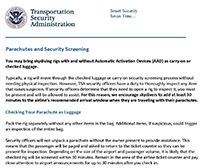
Taking Parachutes Along
As a result of USPA and Parachute Industry Association efforts, the Transportation Security Administration has issued nationwide guidance to its screeners, inspectors, and supervisors about the carriage of parachute rigs on board commercial airlines. First and foremost, the directive makes it absolutely clear that the TSA allows parachutes on board as both carry-on and checked items, with or without Automatic Activation Devices. Finally, the guidance describes how skydivers should prepare to have their parachutes inspected. Please print a copy of “What Can I Bring” from the TSA website.
Here is what skydivers need to know.
While rigs with or without AADs are now officially accepted as carry-on and checked items, skydivers may still encounter occasional problems. Screeners have a duty to thoroughly inspect parachutes in accordance with SOPs. Screeners have been advised that under no circumstances are they to touch or pull handles or otherwise forcefully open any parachute. Further, if screeners determine that it is necessary to open a rig for complete inspection, the owner of the rig must be present and allowed to assist. For this reason, skydivers are advised to add at least 30 minutes to the airline's recommended arrival window.
The TSA uses a variety of explosive detection systems at various airports. USPA has run a variety of rigs with AADs through the systems at a TSA lab. Results show that rigs and components will not trigger explosive detection systems. However, there are a variety of substances that skydivers may encounter in everyday life that will trigger these systems, things like grass fertilizer, fireworks, and firearms residue that contain nitrates, and hand lotion which contains glycerides. As a result, someone who has recently walked a golf course, shot off fireworks or firearms, or applied hand lotion, and then packed their rig for travel may have inadvertently caused their rig to trigger a trace detection machine, which will require the screener to open a rig for thorough inspection.
Here are suggested ways to make traveling with a parachute easier.
Carry-On
Skydivers may find that taking their rig as a carry-on item may prove to be more hassle-free than checking the rig. Rigs should be inside a gear bag or other suitable carry-on container. No other items should be packed with the parachute, as they may interfere with the parachute screening by not allowing the inspector to see a clear image of the rig. Obvious TSA attention-getters are things like lead weights, hook knives, and flotation gear. Such items should be checked if possible. Screeners should no longer be surprised or confused by x-ray images of AAD-equipped rigs. If screeners suspect an item in the bag for some reason, they will request to look inside the bag. If suspicions remain, the screener may swab the bag and rig to determine if there are any trace explosives. The screener may then require the rig to be opened for a thorough search only if trace explosives are detected. If a rig must be opened, the owner will be allowed to assist and the inspection may be done in a location away from the checkpoint. The owner will be allowed to repack the rig. All in all, chances are excellent that the rig will uneventfully pass through the x-ray machine.
Checked Item
Commercial airports run all checked bags through sophisticated explosive detection systems. Bags are only hand-searched if they trigger the machine, so chances are slight that a gear bag and rig will need to be opened. Small commercial airports use less sophisticated explosive trace detection machines supplemented by random hand searches. If the screener determines that the parachute needs to be opened, the owner will be paged and told where to report to be present and assist.
Following check-in, it is likely that the checked rig will be screened by TSA within 30 minutes. Therefore, remaining near the ticket counter for 30 minutes and paying close attention to airport paging announcements could hasten the process if the TSA needs to open the rig. If TSA cannot locate the rig's owner, the rig will not be transported on the flight.
Problems?
Skydivers encountering problems with screeners should request that the screener's supervisor become involved. Skydivers should insist that the supervisor review "The Parachute Screening section of the Screening Checkpoint Standard Operating Procedure." Skydivers encountering unsatisfactory treatment should contact USPA at (540) 604-9740 or email us.